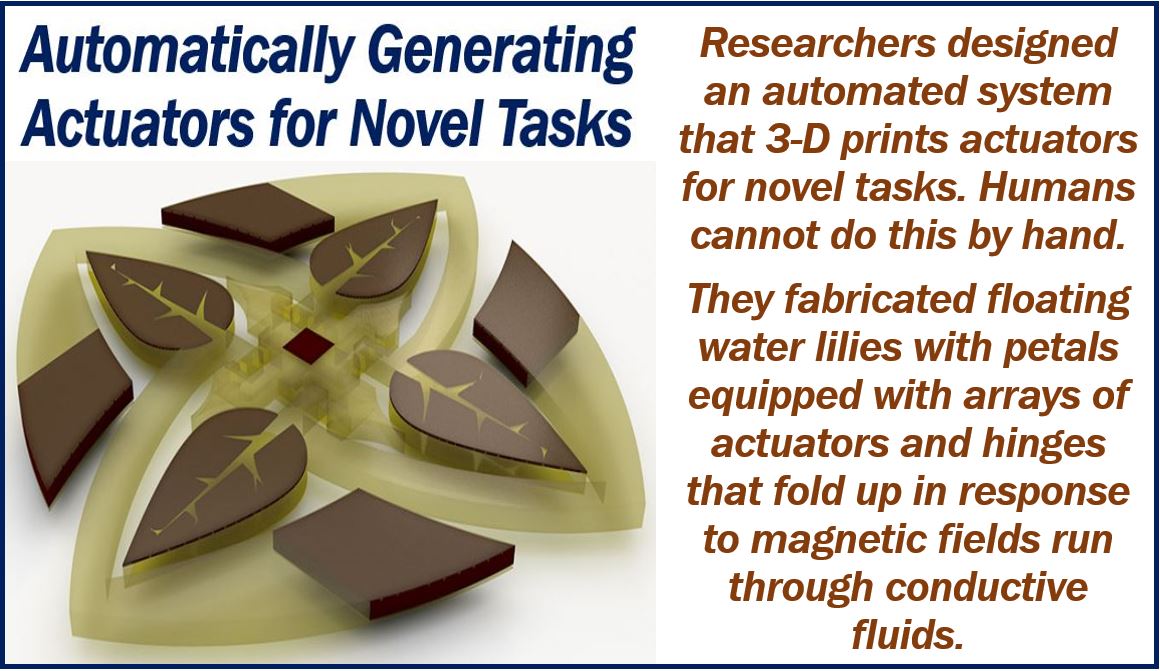Researchers designed an automated system using 3-D prints that generates robotic parts for novel tasks. The parts, called actuators, are optimized according to a huge number of specifications. The automated system does automatically what a human could never do by hand.
 When designing an actuator requires too many variables for a human being to test by hand, the automated system can step in.
When designing an actuator requires too many variables for a human being to test by hand, the automated system can step in.
Actuators are devices that control robotic systems mechanically in response to electric signals.
The researchers, from the Massachusetts Institute of Technology (MIT), Cambridge, USA, and University of Grenoble Alpes, Inria, France, wrote about their study and achievements in the journal Science Advances (citation below).
The authors demonstrated the system by creating actuators that show different black-and-white images at various angles.
For example, one actuator, when laid flat, portrayed a portrait of the Dutch painter Vincent van Gogh. however, when its activated, tilted at an angle, it portrays ‘The Scream,’ by the Norwegian painter Edvard Munch.
The research team also 3-D printed floating lilies with petals. The arrays of hinges and actuators respond to magnetic fields (run through conductive fluids) by folding up.
Actuators made from three different materials
According to an MIT press release:
“The actuators are made from a patchwork of three different materials, each with a different light or dark color and a property — such as flexibility and magnetization — that controls the actuator’s angle in response to a control signal.”
A computer program initially breaks down the actuator design into millions of voxels, i.e., three-dimensional pixels. Each voxel can be filled with any of the three materials.
The software then runs millions of different simulations in which voxels are filled with different combinations of materials. It eventually finds the right placement of each material in each voxel so that two different images can be generated. At one angle you see one image, while at another angle you get a different image.
A 3-D printer then creates the actuator by placing the correct material into the right voxel. It does this layer after layer.
Goal – automatically find the best design
First author, Subramanian Sundaram PhD, said:
“Our ultimate goal is to automatically find an optimal design for any problem, and then use the output of our optimized design to fabricate it. We go from selecting the printing materials, to finding the optimal design, to fabricating the final product in almost a completely automated way.”
Dr. Sundaram was a Ph.D. student at MIT. He is a Postdoctoral Associate at Boston University and the Wyss Institute at Harvard University.
In an Abstract preceding the main article in the journal, the authors wrote:
“The topology optimizer assigns materials for individual voxels (volume elements) while simultaneously optimizing for physical deflection and high-resolution appearance.”
“Unifying a topology optimization-based design strategy with a multimaterial fabrication process enables the creation of complex actuators and provides a promising route toward automated, goal-driven fabrication.”
Citation
“Topology optimization and 3D printing of multimaterial magnetic actuators and displays,” Subramanian Sundaram, Melina Skouras, David S. Kim, Louise van den Heuvel and Wojciech Matusik. Science Advances, 12 Jul 2019: Vol. 5, no. 7, eaaw1160. DOI: 10.1126/sciadv.aaw1160.
